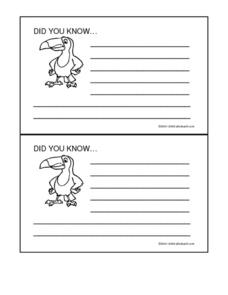Curated OER
What Are Living Parts of Ecosystems?
In this ecosystem worksheet, students will write down 4 living parts of an ecosystem and then write in the effect these living things have on the ecosystem.
Curated OER
What Do Animals Eat?
In this animal diet worksheet, students will brainstorm what animals eat and write it down in a graphic organizer. Then students will brainstorm what people should eat and write it down.
Curated OER
What Are Three States of Matter?
In this states of matter worksheet, students will write down a main idea relating to the three states of matter. Then students will write in five supporting details in this graphic organizer.
Curated OER
What Can Change an Object's Motion?
In this object in motion worksheet, students will brainstorm ideas of what can change an object's motion. Then the student will write in supporting details for each idea in a graphic organizer.
Curated OER
Simple Machines
In this simple machines worksheet, students will write in 6 examples of simple machines and then write in what those simple machines can do.
Curated OER
How is Sound Made?
In this sound worksheet, students will fill in the blank of 4 facts based on what sound different objects make. Based on those facts, students will write in a conclusion about how sound is made.
Curated OER
How Do Living Things Compete?
In this living things worksheet, students will brainstorm and fill in a graphic organizer focusing on the main idea of how living things compete. Then students will add four details to support their main idea.
Curated OER
What Are the Needs of Living Things?
In this living things worksheet, students will write down two facts about what a living thing needs to survive. Using these facts, students will draw a conclusion to how those needs are met.
Curated OER
Traits of Living Things
In this characteristics of living things worksheet, students will brainstorm five traits of living things and fill in a graphic organizer.
Curated OER
How Do Adaptations Help Living Things?
In this adaptations worksheet, students will brainstorm a problem that a living thing might face in its environment. Then students will write down what solution or adaptation that living thing has that allows it to survive that...
Curated OER
Uses for Natural Resources
In this natural resources worksheet, students will brainstorm different uses for air and water resources. Students will fill in four answers in a graphic organizer.
Curated OER
Did You Know Cards- Rainbow Circles
In this did you know cards worksheet, students use two brightly colored circles to write facts. There are no directions for the use of this graphic organizer.
Curated OER
Toucan- Did You Know Cards
In this information collecting worksheet, students write information on two cards that show a clip art graphic of a toucan on them. There are no directions given with this worksheet.
Curated OER
The Month of April (Calendar in Color)
In this math and language arts worksheet, students create their own calendar for the month of April. Students place the numbers 1-30 correctly on the calendar which has been labeled with the days of the week.
Curated OER
Blank Clock
In this math worksheet, students will focus on telling time. Students will use the blank clock provided to complete the hands and the numbers on the face of the clock.
Curated OER
Blank Primary Writing Lines: Horizontal Format
In this language arts activity, students use the blank primary writing lines for any creative writing or handwriting purpose. There are 7 primary lines in a horizontal format.
Curated OER
Twenty Pages of Children's Recipes
For this recipe booklet worksheet, young scholars see twenty simple recipes that include student friendly ingredients and directions. There are no directions given with these recipes.
Curated OER
Thanks for Lighting Up Our School Writer's Page
In this Christmas worksheet, students write a thank you note to a person who "lights" up the school. They see a string of Christmas lights that go across the page with the words, "Thanks for Lighting Up our School."
Curated OER
Addition Chart
In this math worksheet, students use the graphic organizer to write addition problems with different amounts for the addends while solving for the sums.
Curated OER
Homonym, Homophone, Homograph
In this language arts worksheet, students learn the difference between homophones, homographs, and heteronyms by reading this informative chart. Detailed examples are given for all. There are no questions on the page.
Curated OER
Novel Study Night of the Twisters
In this reading worksheet, students use this graphic organizer to map the beginning, middle and end of The Night of the Twisters. Students use this "plot pie" to write a few sentences to summarize the story. The graphic organizer is...
Curated OER
Night of the Twisters KW Chart
In this literature response worksheet, pupils read The Night of the Twisters and then complete a KW table. Students record what they know about tornadoes and what they would like to learn.
Curated OER
Hundred Chart
In this learning tool worksheet, students recognize the numbers from 1-100. This chart has multiply uses with various math activities.
Curated OER
Fahrenheit Thermometer
In this math worksheet, students learn to measure temperatures by examining and using this blank Fahrenheit thermometer. There are no directions on the page.

























